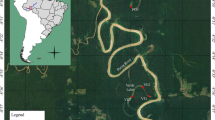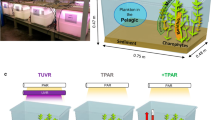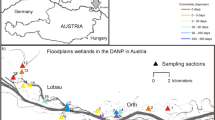Abstract
Morphometric differences between ponds and lakes have implications in habitat-dimensioning and coupling. The prevalence of pelagic over benthic habitats in lakes differs from ponds, where macrophytes dominate, offering both within-meadow free water and support for benthic organisms. We assessed four Mediterranean waterbodies (two ponds and two lakes) situated along an environmental–morphometric gradient, combining a model based on taxonomic composition with a multi-interaction network perspective of habitat coupling. The communities’ composition (both regarding taxa and their corresponding nodes) fits to this gradient. The composition of benthic and within-meadow habitats was similar in the ponds, while in the lakes, the highest similarity occurred between planktonic habitats (pelagic and within-meadow), and the benthic habitat had unshared populations. The network approach suggests two contrasting patterns of habitat coupling between ponds and lakes. Three functional modules, coupled by macrophytes, herbivores, and mixotrophs, emerged in the ponds: a microbial loop, an autotrophic food chain, and macrophytes hosting benthic microalgae. In the lakes, two disconnected modules appeared: the pelagic plankton plus the within-meadow connector herbivores, and the benthos plus the within-meadow primary producers. Within-meadow herbivores and small phytoplankton nodes were central in the pond and lake networks. Furthermore, benthic nodes showed high functional redundancy and were highly influential in spreading the disturbances’ effects. These results demonstrate: (1) the diversity of functional structures in ponds emerging from a mixed composition; (2) the importance of within-meadow organisms as connectors, and (3) the relevance of benthos which has the greatest diversity and redundancy, as well as the most influential network’s elements.






Similar content being viewed by others
Availability of data and materials
Data will be available from the RODERIC Digital Repository (waiting for the link).
References
Adamczuk M (2014) Niche separation by littoral-benthic Chydoridae (Cladocera, Crustacea) in a deep lake—potential drivers of their distribution and role in littoral-pelagic coupling. J Limnol 73:490–501. https://doi.org/10.4081/jlimnol.2014.884
Allesina S, Pascual M (2008) Network structure, predator-prey modules, and stability in large food webs. Theor Ecol 1:55–64. https://doi.org/10.1007/s12080-007-0007-8
Almeida-Neto M, Guimarães P, Lewinsohn TM (2008) On nestedness analyses: rethinking matrix temperature and anti-nestedness. Oikos 116:716–722. https://doi.org/10.1111/j.0030-1299.2007.15803.x
Alva-Martínez AF, Sarma SSS, Nandini S (2007) Effect of mixed diets (cyanobacteria and green algae) of the population growth of the cladocerans Ceriodaphnia dubia and Moina macrocopa. Aquat Ecol 41:579–585. https://doi.org/10.1007/s10452-007-9115-1
Álvarez-Cobelas M, Cirujano S, Montero E, Rojo C, Rodrigo MA, Piña E, Rodríguez-Murillo JC, Soriano O, Aboal M, Marín-Murcia JP, Araujo R (2006) Aquatic ecology and society of ruidera lakes (Central Spain). CSIC, Madrid
Antón-Pardo M, Armengol X (2016) Influence of biotic variables on invertebrate size structure and diversity in coastal wetlands of Southeastern Spain. Estuar Coast Shelf S 180:41–50. https://doi.org/10.1016/j.ecss.2016.06.020
Ballester A, Lacomba I, Oltra C (2006) Ficha informativa de los humedales Ramsar (FIR). https://www.miteco.gob.es/images/es/13_fir_albufera_tcm30-202969.pdf
Barnett AJ, Finlay K, Beisner BE (2007) Functional diversity of crustacean zooplankton communities: towards a trait-based classification. Freshw Biol 52:796–813. https://doi.org/10.1111/j.1365-2427.2007.01733.x
Berlow EL, Neutel AM, Cohen JE, De Ruiter PC, Ebenman B, Emmerson M, Fox JW, Jansen VAA, Jones JI, Kokkoris GD, Logofet DO, McKane AJ, Montoya JM, Petchey O (2004) Interaction strengths in food webs: issues and opportunities. J Anim Ecol 73:585–598. https://doi.org/10.1111/j.0021-8790.2004.00833.x
Bolduc P, Bertolo A, Pinel-Alloul B (2016) Does submerged aquatic vegetation shape zooplankton community structure and functional diversity? A test with a shallow fluvial lake system. Hydrobiologia 778:151–165. https://doi.org/10.1007/s10750-016-2663-4
Borgatti SP, Everett MG, Freeman LC (2002) Ucinet for Windows: software for social network analysis. Analytic Technologies, Harvard
Bucak T, Saraoğlu E, Levi EE, Tavşanoğlu UN, Çakiroğlu AI, Jeppesen E, Beklioğlu M (2012) The influence of water level on macrophyte growth and trophic interactions in eutrophic Mediterranean shallow lakes: a mesocosm experiment with and without fish. Freshw Biol 57:1631–1642. https://doi.org/10.1111/j.1365-2427.2012.02825.x
Burian A, Kainz MJ, Schagerl M, Yasindi A (2014) Species-specific separation of lake plankton reveals divergent food assimilation patterns in rotifers. Freshw Biol 59:1257–1265. https://doi.org/10.1111/fwb.12345
Burks RL, Lodge DM, Jeppesen E, Lauridsen TL (2002) Diel horizontal migration of zooplankton: costs and benefits of inhabiting the littoral. Freshw Biol 47:343–365. https://doi.org/10.1046/j.1365-2427.2002.00824.x
Calero S, Joye DA, Rey-Boissezon A, Rodrigo MA (2017) Time and heat for sexual reproduction: comparing the phenology of Chara hispida of two populations at different latitudes. Aquat Bot 136:71–81. https://doi.org/10.1016/j.aquabot.2016.09.011
Camacho A, Vicente E, Miracle MR (2001) Ecology of Cryptomonas at the chemocline of a karstic sulfate-rich lake. Mar Freshw Res 52:805–815. https://doi.org/10.1071/MF00097
Carrillo P, Medina-Sánchez JM, Villar-Argaiz M, Bullejos F, Durán C, Bastidas-Navarro M, Souza MS, Balseiro EG, Modenutti BE (2017) Vulnerability of mixotrophic algae to nutrient pulses and UVR in an oligotrophic Southern and Northern hemisphere lake. Sci Rep 7:1–11. https://doi.org/10.1038/s41598-017-06279-9
Cirujano S (2013) Flora acuática. In: Álvarez-Cobelas M, Fernández-López J (eds) Limnología básica de algunos humedales de Castilla. Serie LimnoIberia, n 1. Grupo de Investigación del Agua, Madrid, pp 131–144
Cirujano S, Medina L (2002) Plantas acuáticas de las lagunas y humedales de Castilla—La Mancha. Real Jardín Botánico CSIC, Madrid
Clegg MR, Maberly SC, Jones RI (2007) Behavioral response as a predictor of seasonal depth distribution and vertical niche separation in freshwater phytoplanktonic flagellates. Limnol Oceanogr 52:441–455. https://doi.org/10.4319/lo.2007.52.1.0441
Cohen JE (1978) Derivatives of the spectral radius as a function of non-negative matrix elements. Math Proc Cambridge 83:183–190. https://doi.org/10.1017/S0305004100054438
Colwell RK, Coddington JA (1994) Estimating terrestrial biodiversity through extrapolation. Philos Trans R Soc Lond B 345:101–118. https://doi.org/10.1098/rstb.1994.0091
Declerck SAJ, Bakker ES, van Lith B, Kersbergen A, van Donk E (2011) Effects of nutrient additions and macrophyte composition on invertebrate community assembly and diversity in experimental ponds. Basic Appl Ecol 12:466–475. https://doi.org/10.1016/j.baae.2011.05.001
Dolson R, McCann H, Rooney N, Ridgway M (2009) Lake morphometry predicts the degree of habitat coupling by a mobile predator. Oikos 118:1230–1238. https://doi.org/10.1111/j.1600-0706.2009.17351.x
Freeman LC (1977) A set of measures of centrality based on betweenness. Sociometry 40:35–41. https://doi.org/10.2307/3033543
Freeman LC (1978) Centrality in social networks conceptual clarification. Soc Networks 1:215–239. https://doi.org/10.1016/0378-8733(78)90021-7
Gebrehiwot M, Kifle D, Triest L (2017) Emergent macrophytes support zooplankton in a shallow tropical lake: a basis for wetland conservation. Environ Manage 60:1127–1138. https://doi.org/10.1007/s00267-017-0935-z
Guimarães PR, Guimarães P (2006) Improving the analyses of nestedness for large sets of matrices. Environ Modell Softw 21:1512–1513. https://doi.org/10.1016/j.envsoft.2006.04.002
Guimerà R, Amaral LA (2005) Functional cartography of complex metabolic networks. Nature 433:895–900. https://doi.org/10.1038/nature03288
Hammer O, Harper D, Ryan PD (2001) Past: paleontological statistics software package for education and data analysis. Palaeontol Electronica 4:1–9
Heino J, Melo AS, Siqueira T, Soininen J, Valanki S, Bini LM (2014) Metacommunity organisation, spatial extent and dispersal in aquatic systems: patterns, processes and prospects. Freshw Biol 60:845–869. https://doi.org/10.1111/fwb.12533
Ings TC, Montoya JM, Bascompte J, Blüthgen N, Brown L, Dormann CF, Edwards F, Figueroa D, Jacob U, Jones JI, Lauridsen RB, Ledger ME, Lewis HM, Olesen JM, Van Veen F, Warren PH, Woodward G (2009) Review: ecological networks—beyond food webs. J Anim Ecol 78:253–269. https://doi.org/10.1111/j.1365-2656.2008.01460.x
Jeppesen E, Meerhoff M, Davidson TA, Trolle D, Søndergaard M, Lauridsen TL, Beklioglu M, Brucet S, Volta P, González-Bergonzoni I, Nielsen A (2014) Climate change impacts on lakes: an integrated ecological perspective based on a multi-faceted approach, with special focus on shallow lakes. J Limnol 73:88–111. https://doi.org/10.4081/jlimnol.2014.844
Jones CG, Lawton JH (1995) Linking species and ecosystems. Chapman and Hall, New York
Jordán F, Liu WC, van Veen FJF (2003) Quantifying the importance of species and their interactions in a host-parasitoid community. Community Ecol 41:79–88. https://doi.org/10.1556/ComEc.4.2003.1.12
Kéfi S, Berlow EL, Wieters EA, Joppa LN, Wood SA, Brose U, Navarrete SA (2015) Network structure beyond food webs: mapping non-trophic and trophic interactions on Chilean rocky shores. Ecology 96:291–303. https://doi.org/10.1890/13-1424.1
Kéfi S, Miele V, Wieters EA, Navarrete SA, Berlow EL (2016) How structured is the entangled bank? The surprisingly simple organization of multiplex ecological networks leads to increase persistence and resilience. PLoS Biol 14:e1002527. https://doi.org/10.1371/journal.pbio.1002527
Kisand V, Nõges T (2004) Abiotic and biotic factors regulating dynamics of bacterioplankton in a large shallow lake. FEMS Microbiol Ecol 50:51–62. https://doi.org/10.1016/j.femsec.2004.05.009
Kosten S, Jeppesen E, Huszar VLM, Mazzeo N, Van Nes EH, Peeters ETHM, Scheffer M (2011) Ambiguous climate impacts on competition between submerged macrophytes and phytoplankton in shallow lakes. Freshw Biol 56:1540–1553. https://doi.org/10.1111/j.1365-2427.2011.02593.x
Kutikova LA (2003) Bdelloid rotifers (Rotifera, Bdelloidea) as a component of soil and land biocenoses. Biol Bull 30:271–274. https://doi.org/10.1023/A:1023811929889
Leibold MA, Holyoak M, Mouquet N, Amarasekare P, Chase JM, Hoopes MF, Holt RD, Shurin JB, Law R, Tilman D, Loreau M, Gonzalez A (2004) The metacommunity concept: a framework for multi-scale community ecology. Ecol Lett 7:601–613. https://doi.org/10.1111/j.1461-0248.2004.00608.x
Ludovisi A, Todini C, Pandolfi P, Taticchi MI (2008) Scale patterns of diel distribution of the copepod Cyclops abyssorum Sars in a regulated lake: the relative importance of physical and biological factors. J Plankton Res 30:495–509. https://doi.org/10.1093/plankt/fbn017
Lyche-Solheim A, Feld CK, Birk S, Phillips G, Carvalho L, Morabito G, Mischke U, Willby N, Søndergaard M, Hellsten S, Kolada A, Mjelde M, Böhmer J, Miler O, Pusch MT, Argillier C, Jeppesen E, Lauridsen TL, Poikane S (2013) Ecological status assessment of European lakes: a comparison of metrics for phytoplankton, macrophytes, benthic invertebrates and fish. Hydrobiologia 704:57–74. https://doi.org/10.1007/s10750-012-1436-y
Martínez ND (1992) Constant connectance in community food webs. Am Nat 139:1208–1218. https://doi.org/10.1086/285382
Martín-González AM, Dalsgaard B, Olesen JM (2010) Centrality measures and the importance of generalist species in pollination networks. Ecol Complex 7:36–43. https://doi.org/10.1016/j.ecocom.2009.03.008
McCann KS, Rasmussen JB, Umbanhowar J (2005) The dynamics of spatially coupled food webs. Ecol Lett 8:513–523. https://doi.org/10.1111/j.1461-0248.2005.00742.x
Medina-Sánchez JM, Villar-Argaiz M, Carrillo P (2004) Neither with nor without you: a complex algal control on bacterioplankton in a high mountain lake. Limnol Oceanogr 49:1722–1733. https://doi.org/10.4319/lo.2004.49.5.1722
Nakajima H (1992) Sensitivity and stability of flow networks. Ecol Modell 62:123–133
Naselli-Flores L, Barone R (2012) Phytoplankton dynamics in permanent and temporary Mediterranean waters: is the game hard to play because of hydrological disturbance? Hydrobiologia 698:147–159. https://doi.org/10.1007/s10750-012-1059-3
Novak M, Yeakel JD, Noble AE, Doak DF, Emmerson M, Estes JA, Jacob U, Tinker T, Wootton T (2016) Characterizing species interactions to understand press perturbations: what is the community matrix? Annu Rev Ecol Evol S 47:409–432. https://doi.org/10.1146/annurev-ecolsys-032416-010215
Olesen JM, Bascompte J, Dupont YL, Jordano P (2007) The modularity of pollination networks. Proc Natl Acad Sci USA 104:19891–19896. https://doi.org/10.1073/pnas.0706375104
Palma-Silva C, Albertoni EF, Esteves FA (2002) Clear water associated with biomass and nutrient variation during the growth of a Charophyte stand after a drawdown, in a tropical coastal lagoon. Hydrobiologia 482:79–87. https://doi.org/10.1023/A:1021295811688
Parcerisas L, Marrull J, Pino J, Tello E, Coll F, Basnou C (2012) Land use changes, landscape ecology and their socioeconomic driving forces in the Spanish Mediterranean coast (El Maresme County, 1850–2005). Environ Sci Policy 23:120–132. https://doi.org/10.1016/j.envsci.2012.08.002
Pinel-Alloul B, Niyonsenga T, Legendre P (1995) Spatial and environmental components of freshwater zooplankton structure. Écoscience 2:1–19. https://doi.org/10.1080/11956860.1995.11682263
Pomeroy LR, Williams PJ, Azam F, Hobbie JE (2007) The microbial loop. Oceanography 20:28–33. https://doi.org/10.5670/oceanog.2007.45
Proulx SR, Promislow DEL, Phillips PC (2005) Network thinking in ecology and evolution. Trends Ecol Evol 20:345–353. https://doi.org/10.1016/j.tree.2005.04.004
Puche E, Sánchez-Carrillo S, Álvarez-Cobelas M, Pukacz A, Rodrigo MA, Rojo C (2018) Effects of overabundant nitrate and warmer temperatures on charophytes: the roles of plasticity and local adaptation. Aquat Bot 146:15–22. https://doi.org/10.1016/j.aquabot.2018.01.003
Puche E, Rojo C, Ramos-Jiliberto R, Rodrigo MA (2020a) Structure and vulnerability of the multi-interaction network in macrophyte-dominated lakes. Oikos 129:35–48. https://doi.org/10.1111/oik.06694
Puche E, Rojo C, Rodrigo MA (2020b) Multi-interaction network performance under global change: a shallow ecosystem experimental simulation. Hydrobiologia. https://doi.org/10.1007/s10750-020-04359-y
Puche E, Jordan F, Rodrigo MA, Rojo C (2020c) Non-trophic key players in aquatic ecosystems: a mesocosm experiment. Oikos. https://doi.org/10.1111/oik.07476
Rakowski CJ, Farrior CE, Manning SR, Leibold MA (2020) Predator complementarity dampens variability of phytoplankton biomass in a diversity-stability trophic cascade. bioRxiv. https://doi.org/10.1101/851642
Roberts EC, Laybourn-Parry J (2001) Mixotrophic cryptophytes and their predators in the Dry Valley lakes of Antarctica. Freshw Biol 41:737–746. https://doi.org/10.1046/j.1365-2427.1999.00401.x
Rodrigo MA, Rojo C, Segura M, Alonso-Guillén JL, Martín M, Vera P (2015) The role of charophytes in a Mediterranean pond created for restoration purposes. Aquat Bot 120:101–111. https://doi.org/10.1016/j.aquabot.2014.05.004
Rojo C, Álvarez-Cobelas M, Benavent-Corai J, Barón-Rodríguez MM, Rodrigo MA (2012) Trade-offs in plankton species richness arising from drought: insights from long-term data of a National Park wetland (central Spain). Biodivers Conserv 698:2453–2476. https://doi.org/10.1007/s10531-012-0307-1
Rojo C, Segura M, Rodrigo MA (2013a) The allelopathic capacity of submerged macrophytes shapes the microalgal assemblages from a recently restored coastal wetland. Ecol Eng 58:149–155. https://doi.org/10.1016/j.ecoleng.2013.06.019
Rojo C, Segura M, Cortés F, Rodrigo MA (2013b) Allelopathic effects of microcystin-LR on the germination, growth and metabolism of five charophyte species and one submerged angiosperm. Aquat Toxicol 144–145:1–10. https://doi.org/10.1016/j.aquatox.2013.09.013
Rojo C, Mosquera Z, Álvarez-Cobelas M, Segura M (2017) Microalgal and cyanobacterial assemblages on charophytes: a metacommunity perspective. Fundam Appl Limnol 190:97–115. https://doi.org/10.1127/fal/2017/1032
Rojo C, Puche E, Rodrigo MA (2019) The antagonistic effect of UV radiation on warming or nitrate enrichment depends on ecotypes of freshwater macroalgae (charophytes). J Phycol 55:714–729. https://doi.org/10.1111/jpy.12859
Sánchez-Carrillo S, Álvarez-Cobelas M (2019) Limnologia de la Laguna de Somolinos (Guadalajara). Síntesis del conocimiento científico. Madrid: CSIC.
Schindler DE, Scheuerell MD (2002) Habitat coupling in lake ecosystems. Oikos 98:177–189. https://doi.org/10.1034/j.1600-0706.2002.980201.x
Schriver P, Bøgestrand J, Jeppesen E, Søndergaard M (1995) Impact of submerged macrophytes on fish-zooplankton-phytoplankton interactions: large-scale enclosure experiments in a shallow eutrophic lake. Freshw Biol 33:255–270. https://doi.org/10.1111/j.1365-2427.1995.tb01166.x
Shannon CE, Weaver W (1949) The mathematical theory of communication. University of Illinois Press, Urbana
Shoemaker LG, Melbourne BA (2016) Linking metacommunity paradigms to spatial coexistence mechanisms. Ecology 97:2436–2446. https://doi.org/10.1002/ecy.1454
Shurin JB, Borer ET, Seabloom EW, Anderson K, Blanchette CA, Broitman B, Cooper SD, Halperm BS (2002) A cross-ecosystem comparison of the strength of trophic cascades. Ecol Lett 5:785–791. https://doi.org/10.1046/j.1461-0248.2002.00381.x
Siehoff S, Hammers-Wirtz M, Strauss T, Ratte HT (2008) Periphyton as alternative food source for the filter-feeding cladoceran Daphnia magna. Freshw Biol 54:15–23. https://doi.org/10.1111/j.1365-2427.2008.02087.x
Søndergaard M, Jeppesen E, Jensen JP (2005) Pond or lake: does it make any difference? Arch Hydrobiol 162:143–165. https://doi.org/10.1127/0003-9136/2005/0162-0143
Søndergaard M, Lauridsen TL, Johansson LS, Jeppesen E (2017) Nitrogen or phosphorus limitation in lakes and its impact on phytoplankton biomass and submerged macrophyte cover. Hydrobiologia 795:35–48. https://doi.org/10.1007/s10750-017-3110-x
Stockner JG, Porter KC (1988) Microbial food web in freshwater planktonic ecosystems. In: Carpenter SR (ed) Complex interactions in Lake Communities. Springer, New York, pp 69–84
Tiberti R, Barbieri M (2011) Evidences of zooplankton vertical migration in stocked and never stocked alpine lakes in Gran Paradiso National Park (Italy). Oceanol Hydrobiol Stud 40:36–42. https://doi.org/10.2478/s13545-011-0027-2
Vadeboncoeur Y, Jeppesen E (2003) From Greenland to green lakes: cultural eutrophication and the loss of benthic pathways in lakes. Limnol Oceanogr 48:1408–1418. https://doi.org/10.4319/lo.2003.48.4.1408
Vadeboncoeur Y, Lodge DM, Carpenter SR (2001) Whole-lake fertilization effects on distribution of primary production between benthic and pelagic habitats. Ecology 82:1065–1077. https://doi.org/10.1890/0012-9658(2001)082[1065:WLFEOD]2.0.CO;2
Vadeboncoeur Y, Vander Zanden MJ, Lodge DM (2002) Putting the lake back together: reintegrating benthic pathways into lake food web models. Bioscience 52:44–54. https://doi.org/10.1641/0006-3568(2002)052[0044:PTLBTR]2.0.CO;2
Vadeboncoeur Y, Sp D, McIntyre PB, Vander Zanden MJ (2014) Is there light after depth? Distribution of periphyton chlorophyll and productivity in lake littoral zones. Freshw Sci 33:524–536. https://doi.org/10.1086/676315
Valentini R, Jordán F (2010) CoSBiLab graph: the network analysis module of CoSBiLab. Environ Modell Softw 25:886–888. https://doi.org/10.1016/j.envsoft.2010.02.001
van Donk E, van de Bund WJ (2002) Impact of submerged macrophytes including charophytes on phyto- and zooplankton communities: allelopathy versus other mechanisms. Aquat Bot 72:261–274. https://doi.org/10.1016/S0304-3770(01)00205-4
Vander Zanden MJ, Vadeboncoeur Y (2002) Fishes as integrators of benthic and pelagic food webs in lakes. Ecology 83:2152–2161. https://doi.org/10.1890/0012-9658(2002)083[2152:FAIOBA]2.0.CO;2
Vander Zanden MJ, Vadeboncoeur Y (2020) Putting the lake back together 20 years later: what in the benthos have we learned about habitat linkages in lakes? Inland Waters. https://doi.org/10.1080/20442041.2020.1712953
Vander Zanden MJ, Chandra S, Park S, Vadeboncoeur Y, Goldman CR (2006) Efficiencies of benthic and pelagic trophic pathways in a subalpine lake. Can J Fish Aquat Sci 63:2608–2620. https://doi.org/10.1890/ES11-00181.1
Wellnitz T, Poff NL (2001) Functional redundancy in heterogeneous environments: implications for conservation. Ecol Lett 4:177–179. https://doi.org/10.1046/j.1461-0248.2001.00221.x
Wetzel RG (2001) Limnology: lake and river ecosystems. Academic Press, San Diego
Zhou S, Huang X, Cai Q (2007) Vertical distribution and migration of planktonic rotifers in Xiangxi Bay of the Three Gorges Reservoir, China. J Freshw Biol 22:441–449. https://doi.org/10.1080/02705060.2007.9664174
Acknowledgements
We thank Sara Calero for her help in the sampling campaigns as well as providing information on the ponds. We thank Miguel Álvarez Cobelas (CSIC, Spain) for some of the information concerning environmental conditions in lakes. Daniel Sheerin, a native English teacher and editor, improved the language in the manuscript. We also appreciate the comments and suggestions of two anonymous reviewers on a previous version of the manuscript.
Funding
This study was supported by the Spanish Ministry of Economy and Competitiveness for research project CGL2014-54502-C2-1-P (including EC FEDER funding). Eric Puche is the holder of a grant (UV-INV-PREDOC16F1-383810) funded by the University of Valencia.
Author information
Authors and Affiliations
Contributions
EP: conception and design of the study, data processing analysis and interpretation, and drafting the manuscript; MAR: conception and design of the study and critical revision; MS: obtaining data; CR: conception and design of the study, data processing analysis and interpretation, drafting the manuscript, and critical revision.
Corresponding author
Ethics declarations
Conflict of interest
The authors declare no conflicts of interest.
Additional information
Publisher's Note
Springer Nature remains neutral with regard to jurisdictional claims in published maps and institutional affiliations.
Supplementary Information
Below is the link to the electronic supplementary material.
Rights and permissions
About this article
Cite this article
Puche, E., Rodrigo, M.A., Segura, M. et al. Habitat coupling mediated by the multi-interaction network linked to macrophyte meadows: ponds versus lakes. Aquat Sci 83, 55 (2021). https://doi.org/10.1007/s00027-021-00809-4
Received:
Accepted:
Published:
DOI: https://doi.org/10.1007/s00027-021-00809-4




